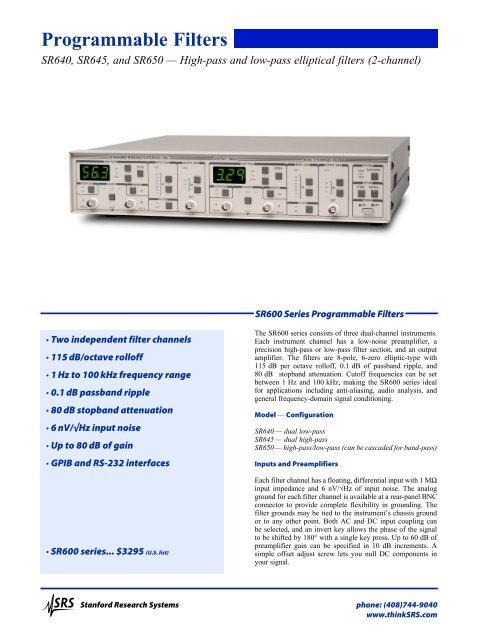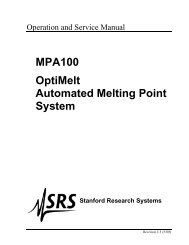Programmable Filters - Stanford Research Systems
Programmable Filters - Stanford Research Systems
Programmable Filters - Stanford Research Systems
- No tags were found...
You also want an ePaper? Increase the reach of your titles
YUMPU automatically turns print PDFs into web optimized ePapers that Google loves.
<strong>Programmable</strong> <strong>Filters</strong>SR640, SR645, and SR650 — High-pass and low-pass elliptical filters (2-channel)SR600 Series <strong>Programmable</strong> <strong>Filters</strong>· Two independent filter channels· 115 dB/octave rolloff· 1 Hz to 100 kHz frequency range· 0.1 dB passband ripple· 80 dB stopband attenuation· 6 nV/√Hz input noise· Up to 80 dB of gain· GPIB and RS-232 interfaces· SR600 series... $3295 (U.S. list)The SR600 series consists of three dual-channel instruments.Each instrument channel has a low-noise preamplifier, aprecision high-pass or low-pass filter section, and an outputamplifier. The filters are 8-pole, 6-zero elliptic-type with115 dB per octave rolloff, 0.1 dB of passband ripple, and80 dB stopband attenuation. Cutoff frequencies can be setbetween 1 Hz and 100 kHz, making the SR600 series idealfor applications including anti-aliasing, audio analysis, andgeneral frequency-domain signal conditioning.Model — ConfigurationSR640 — dual low-passSR645 — dual high-passSR650 — high-pass/low-pass (can be cascaded for band-pass)Inputs and PreamplifiersEach filter channel has a floating, differential input with 1 MΩinput impedance and 6 nV/√Hz of input noise. The analogground for each filter channel is available at a rear-panel BNCconnector to provide complete flexibility in grounding. Thefilter grounds may be tied to the instrument’s chassis groundor to any other point. Both AC and DC input coupling canbe selected, and an invert key allows the phase of the signalto be shifted by 180° with a single key press. Up to 60 dB ofpreamplifier gain can be specified in 10 dB increments. Asimple offset adjust screw lets you null DC components inyour signal.<strong>Stanford</strong> <strong>Research</strong> <strong>Systems</strong> phone: (408)744-9040www.thinkSRS.com
SR600 Series <strong>Programmable</strong> <strong>Filters</strong>Filter CharacteristicsFilter characteristics for the SR600 series are shown below.The exact filter transfer function is given in the specificationssection. (The graph shows the low pass response. The highpassresponse is found by inverting the curve around f =1.) The large amount of excess phase, typical of ellipticalfilters, makes the SR600 series filters optimum in frequencydomainapplications. Note that the 0.1 dB passband ripplespecification for the SR640 series filters is a measuredspecification, not just the theoretical passband ripple ofthe transfer function. Other filter characteristics include anattenuation slope of 115 dB/octave and a stopband attenuation ofgreater than 80 dB. Worst-case phase match between channelsis better than ±0.75° from DC to 100 kHz, and improves to±0.25° for cutoff frequencies below 10 kHz.Post-Filter Gain and BypassingAfter the filter, another amplifier section provides up to20 dB additional gain. The standard output drives loads ofgreater than 300 Ω at 10 Vpp, while the optional high-poweroutput drives 10 Vpp into a 50 Ω load. Each filter may beindependently bypassed from the front panel or from thecomputer interface. When bypassed, both the prefilter andpostfilter gains remain active, and the resulting amplifier hasa bandwidth of 450 kHz.ProgrammingA key feature of the SR600 series is its programmability. BothGPIB and RS-232 interfaces are standard, and all instrumentsettings can be queried and changed via the interfaces. Cutofffrequencies can be changed in under 100 ms, making theSR600 series ideal for applications involving frequency-agilefilters. Careful attention has been paid to minimizing noiseresulting from the presence of the microprocessor and GPIBand RS-232 interfaces. Both the interface electronics and theinstrument’s microprocessor control circuitry are opticallyisolated from the filter sections in order to reduce digitalanalogcrosstalk. The CMOS microprocessor “sleeps” whilethe interface and front panel are inactive in order to reduce theamount of digital noise in the instrument.Stored SettingsUp to nine complete instrument configurations, includingamplifier gains and cutoff frequencies for both channels, can besaved in non-volatile memory. Settings can be stored or recalledfrom the front panel or through the computer interfaces.0 dBGainOverall Phase100 °200 °300 °20 °40 °60 °80 °100 °Phase Distortion-80 dB0.1 1.0 10Frequency (f/fc)SR640 gain response400 °0.1 0.2 0.4 0.6 0.8 1.0Frequency (f/fc)SR640 phase response<strong>Stanford</strong> <strong>Research</strong> <strong>Systems</strong>phone: (408)744-9040www.thinkSRS.com
SR600 Series SpecificationsFilterFrequency rangeTypeRolloffPassband rippleStopband attenuationTransfer Function (Bi-Quad Cascade)Stage 1ω p 0.634752Q 0.543939ω zn/aStage 2ω p 0.805995Q 0.950701ω z 1.675935Stage 3ω p 0.985073Q 2.095314ω z 1.935978Stage 4ω p 1.076768Q 7.375143ω z 2.883197InputImpedanceConfigurationCMRRCouplingInput noiseGainMax. input signal1 Hz to 100 kHz (3-digit resolution)8-pole, 6-zero elliptic115 dB/octave0.1 dB peak to peak (typ.)80 dB (typ.)1 MΩ // 15 pFSingle-ended (A or B) ordifferential (A – B)>85 dB at 100 Hz(input gain >20 dB)AC or DC6 nV/√Hz at 1 kHz (with 60 dBinput gain)0, 10, 20, 30, 40, 50, 60 dB ± 0.2 dB10 Vpp (overload)5 Vpp (no distortion)OutputImpedance300 ΩOption 0110 Vpp into 50 ΩDC offsetAdjustable to 0 VGain0, 10, 20 dB ± 0.5 dBHarmonic distortion
















